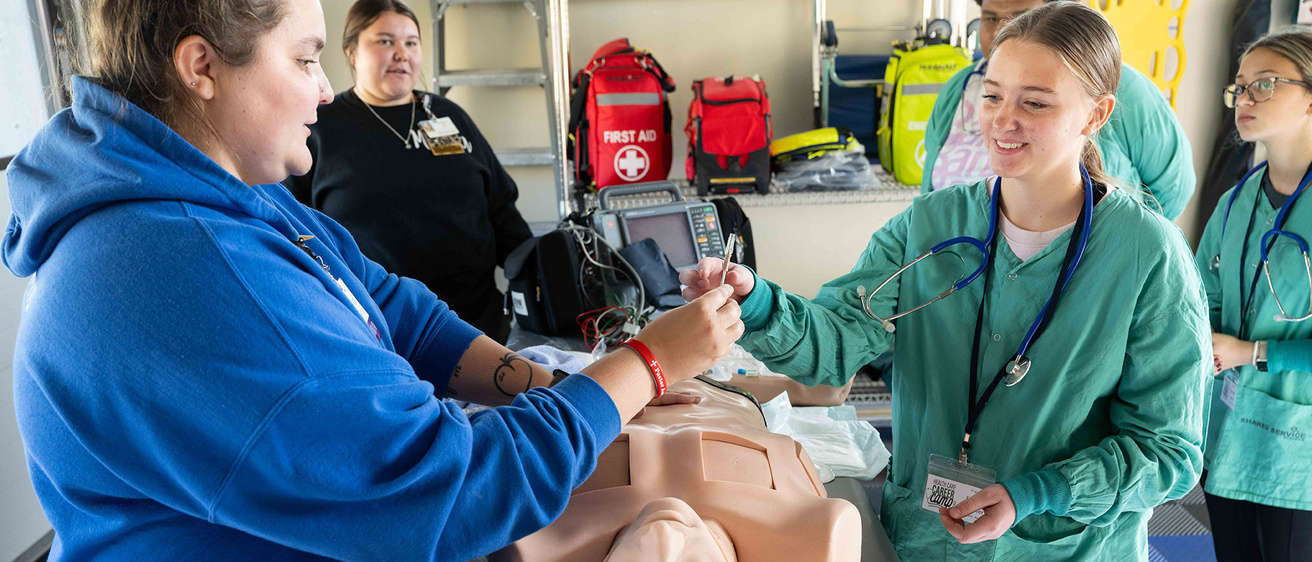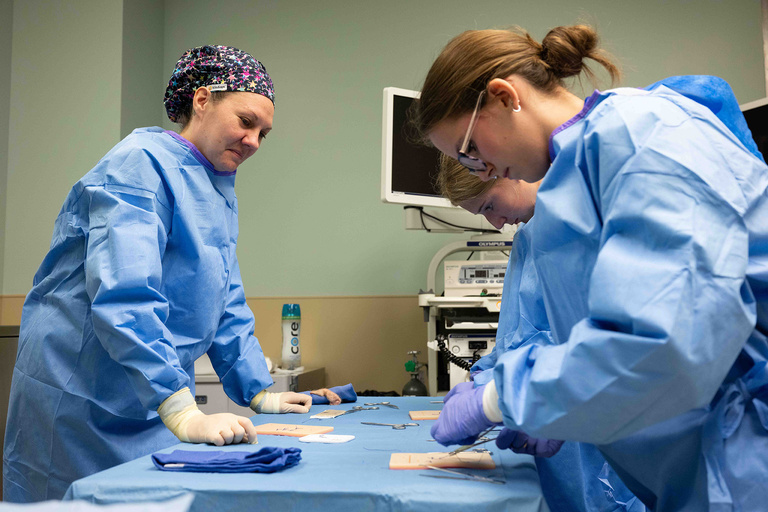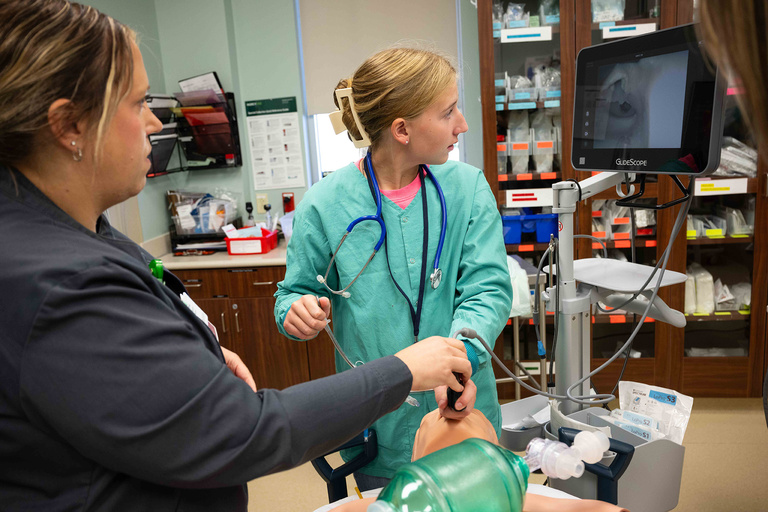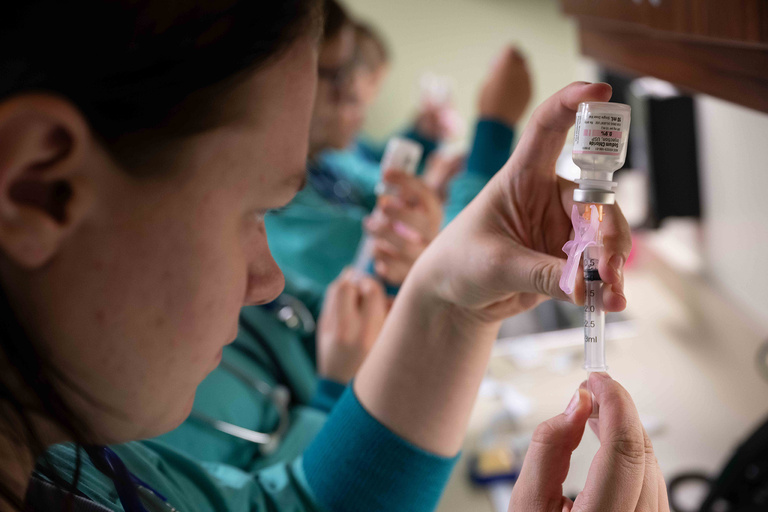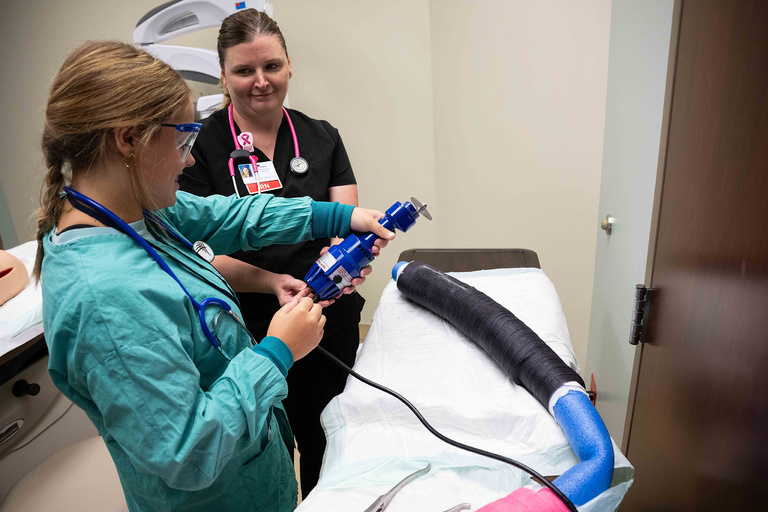The Business Leadership Network in the UI College of Public Health has backed health and wellness initiatives in small to mid-sized towns across Iowa, providing grants and expertise that allow these community efforts to flourish.
Story: Richard C. Lewis
Photography: Tim Schoon
Published: Nov. 14, 2023
The top photo...
Students from Manning, Iowa, and Coon Rapids, Iowa, had the chance for some hands-on experiences at the Health Care Career Camp in Manning, Iowa. The event was funded in part by the Business Leadership Network, an initiative from the University of Iowa College of Public Health.
It was a grisly scene. A 24-year-old male riding without a helmet had crashed his bicycle into a parked car. The man lay unconscious on the pavement, his right leg splayed at an unnatural angle. And his rescue hinged on a group of untrained adolescents.
Although they were participating in a simulation, the students took their responsibilities seriously. Each sprang into action to attend the wounded individual—a life-sized mannequin—guided by professional EMT personnel. Tatum, an eighth grader who goes to school in Manning, Iowa, gently took the head and held it steady while a fellow eighth grade student, Audrey, cut the pants from the man’s wounded leg and applied a vacuum sling to immobilize the limb. They and three others then lifted the patient in unison onto a stretcher and securely loaded him into the ambulance.
The rescue scene was one of several scenarios staged at the Health Care Career Camp this fall in Manning, Iowa, where middle and high school students from school districts in Manning and Coon Rapids learned about potential careers in the medical and health care fields. The all-day event, meticulously organized by staff at the Manning Regional Healthcare Center, was funded in part by the Business Leadership Network, an initiative from the University of Iowa College of Public Health to promote and empower health and wellness in communities throughout Iowa.
Since launching in 2011, the BLN has coordinated 44 health and wellness efforts in 38 small to mid-sized communities in the Hawkeye State, from Red Oak in the southwest to Waukon in the northeast. With funding from the Iowa Farm Bureau Federation for the past eight years, the BLN teams up with local businesses and civic and nonprofit agencies. The focus varies, depending on each community’s need. The BLN has spearheaded community public health initiatives that address a broad range of needs with particular emphasis on issues of concern in rural areas, including aging, agricultural health and safety, cyberbullying, immunizations, nutrition and physical activity, substance use, and mental health, among many others.
The goal, explains Edith Parker, dean of the College of Public Health, is to match the college’s resources and expertise with each community’s identified priority.
“In public health, it’s critical to listen to local voices and engage communities in health solutions,” Parker says. “When we meet communities where they are and bring resources to support local priorities, there’s a much better chance of improving health outcomes.”
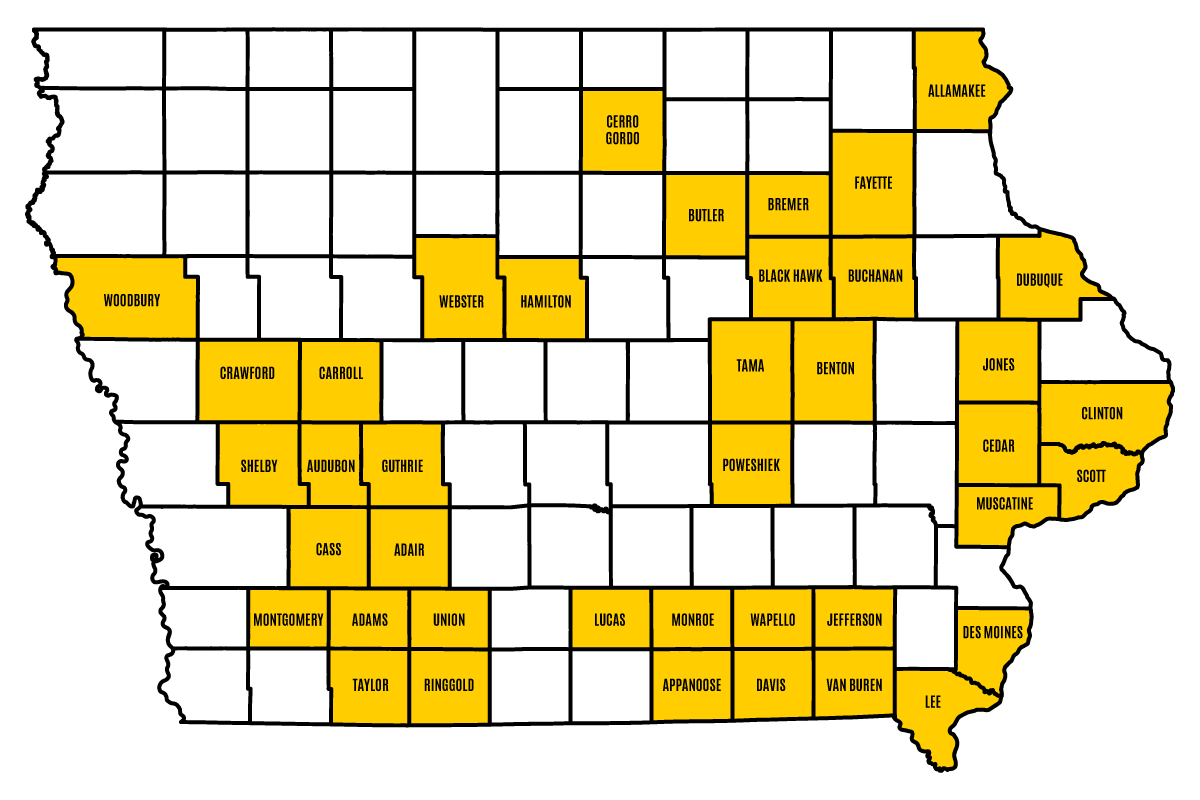
Since launching in 2011, the Business Leadership Network in the University of Iowa College of Public Health has coordinated health and wellness efforts in 40 counties in the Hawkeye State.
How it all began
The idea for the BLN germinated in 2010, when Sue Curry, then dean of the College of Public Health, convened a regular meeting of the college’s external board of advisors, many of whose members hailed from major businesses such as John Deere, IBM, and Principal. At that meeting, board member Tom Slater, a former state legislator who owned a policy consulting business based in Des Moines, asked how the college could connect with communities in the state that were not major cities. Curry liked the idea, and asked Slater to solicit ideas and draft a plan.
That document, created in December 2010, targeted micropolitan areas—essentially medium-sized towns. Curry, Slater, and others sought to enlist businesses embedded in these towns to be fully involved.
“The premise was that small businesses have a major interest in the well-being of their communities,” recalls Curry, who was dean from 2008 to 2017 (when she was appointed interim executive vice president and provost) and is now dean emerita at the college. “You want your workers to be healthy, you want their families to be healthy, you want the community to be a place where people come and thrive. That’s what we in public health are all about, too.”
The next step: find receptive businesses within interested communities. Curry focused first on communities in north-central and south-central Iowa, among them Fort Dodge, Mason City, Storm Lake, Centerville, and Ottumwa. At each town, Curry and a delegation from the college would meet with business, civic, and nonprofit leaders and engaged residents to determine each community’s main needs.
Those first engagements could be challenging, but they also bore serendipitous fruit. At one initial community forum in Ottumwa, for instance, Curry sat down at a table centered around a discussion on healthy aging. A woman described her frustration with older residents being unable to continue living in their homes, because they either aren’t physically able to maintain them, or they don’t have the money to pay for repairs. Across the table, a local representative from the U.S. Department of Agriculture said there was a grant program for those situations, and he was looking for applicants.
“That representative came up to me at the end of the forum,” Curry recalls. “He indicated that he’d come to the event with low expectations, but in the end, he said it was the best meeting he’d ever attended.”
From those first partnerships, the BLN has expanded throughout Iowa.
“This is one of the most fun things I’ve ever done in my career, and I’m so happy that it sustains,” Curry says.
“The premise was that small businesses have a major interest in the well-being of their communities. You want your workers to be healthy, you want their families to be healthy, you want the community to be a place where people come and thrive. That’s what we in public health are all about, too.”
Momentum in Muscatine
BLN funding can lead to a rolling impact, as evidenced in Muscatine.
In 2017, Charla Schafer, with the Muscatine Center for Social Action at the time, applied for funding to buy food for homeless families making the transition into housing. After receiving a BLN grant, the program widened: Schafer expanded the housing transition effort into Fueling the Future, a full-throttle initiative to help families in Muscatine and Louisa counties become economically self-sustaining by supporting them with meals, child care, transportation, housing, paid tuition for coursework while they completed a multi-week certificate program in a high-demand field, and eventual employment.
The seed money from the BLN for Fueling the Future allowed Schafer and her network of community partners to leverage additional funding from local, state, and national sources, culminating in a $900,000 grant to Fueling the Future from the federal Health Resources & Services Administration, an agency of the U.S. Department of Health and Human Services.
The funding matters, but the BLN-Muscatine partnership is about more than money. Researchers in the College of Public Health work closely with Schafer’s team to continually evaluate Fueling the Future and to help identify opportunities to strengthen the program. The researchers attend community meetings, gather and analyze data about the program’s impact, and track whether and how families receive tangible benefits.
Case in point: College of Public Health researchers learned early on through their data analysis that families with three or more children were less likely to enroll in classes at the community college.
“That turned out to be real-time data that suggested there’s a gap in the program, and they need to figure out how to solve that, or they’re not going to be able to reach all those who could benefit from the program,” says Rima Afifi, professor in the Department of Community and Behavioral Health in the College of Public Health who has been directly involved with Fueling the Future. “By the next time we gave them the data, they had solved that piece, meaning families with three or more children were as successful in enrollment as families with fewer children.”
Researchers in public health and in the Tippie College of Business are working on a model to gauge whether it’s financially advantageous to begin creating housing for needy families, versus the costs to the community to help families when there is a lack of affordable housing.
“The professional support and academic expertise we have received has been unparalleled,” says Schafer, who is president of the Community Foundation of Greater Muscatine. “The partnership is instrumental in our aims for greater program efficacy, scalable outcomes, fewer hungry children, and stabilized families for our community and beyond.”
Afifi and others in the college, such as Heidi Haines, research support coordinator and evaluator in the College of Public Health, have been assisting Fueling the Future since summer 2020 with gathering and interpreting all sorts of data. For example, the researchers record all meetings involving Fueling the Future members to help them gain context for which issues have been addressed and how the program has advanced.
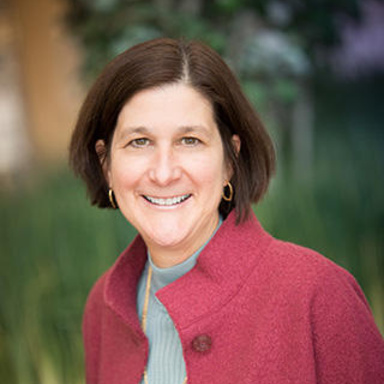
“In public health, it’s critical to listen to local voices and engage communities in health solutions. When we meet communities where they are and bring resources to support local priorities, there’s a much better chance of improving health outcomes.”
In addition, Afifi and her team hold interviews with other stakeholders, such as Muscatine Community College, where parents in the Fueling the Future program take classes.
Perhaps most gratifying, Afifi says, is the conversations she has had with families in the program.
“That part has been just amazing, to hear how Fueling the Future has changed their lives,” says Afifi, who as director of the Prevention Research Center for Rural Health in the College of Public Health notes the Muscatine model can be put into practice nationally.
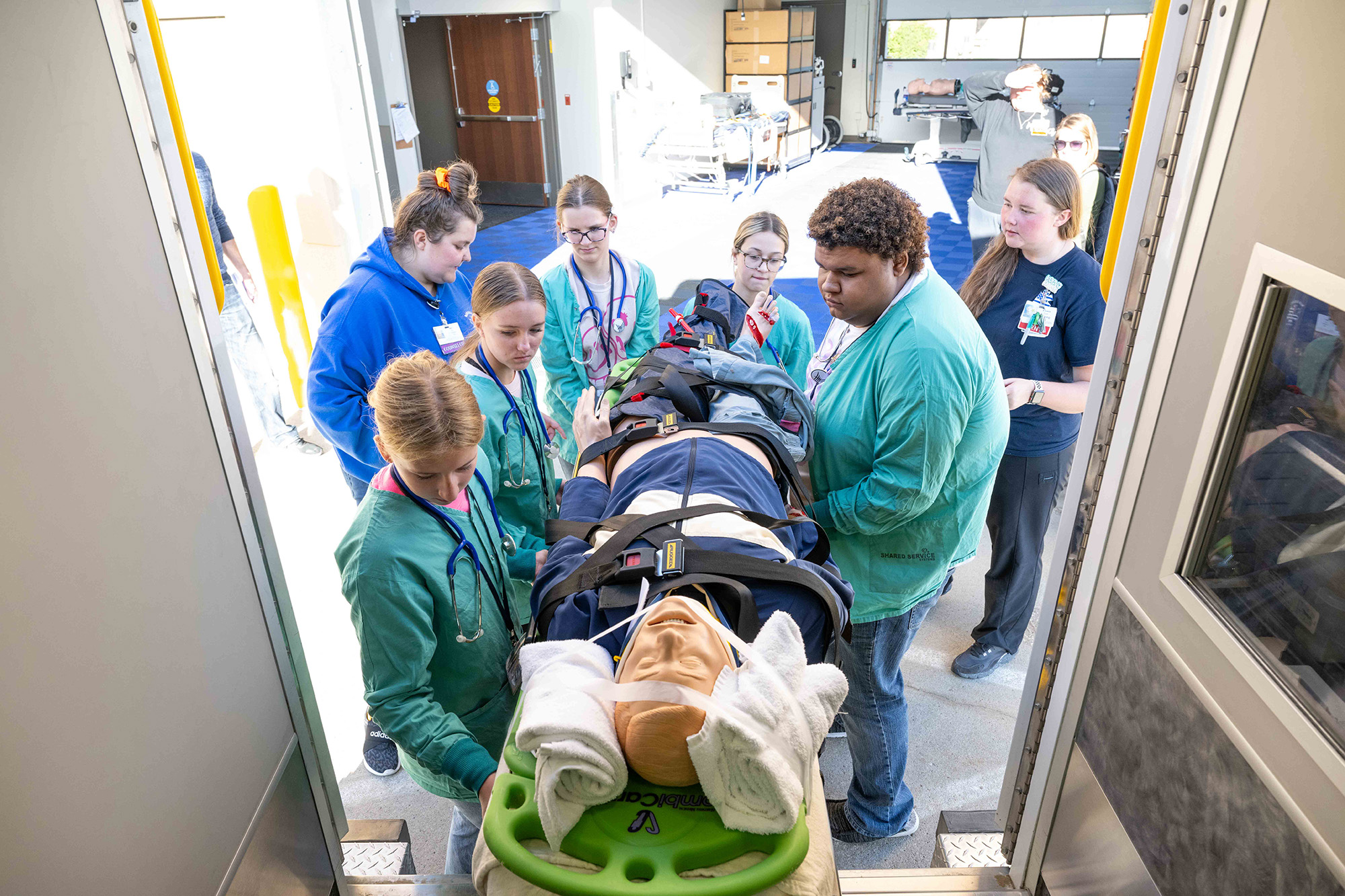
Students from school districts in Manning, Iowa, and Coon Rapids, Iowa, lift a mannequin into an ambulance during a rescue scenario at the Health Care Career Camp held in Manning. The mannequin represented a cyclist who injured a leg in an accident.
Marketing health care careers in Manning
At the Manning Regional Healthcare Center, four groups of students, totaling about two dozen youth from grades 8 to 12, rotated among several stations, learning what happens on the front lines of the 17-bed critical-access hospital, which serves patients in Carroll and three surrounding counties in west-central Iowa.
At the emergency room station, the students intubated a mannequin, their eyes wide as they watched on an overhead screen their progress in guiding a breathing tube into a trachea. At the laboratory stop, they practiced drawing blood; at the surgical and anesthesia center, they took turns stitching a wound and using a bone saw; in radiology, they looked awestruck at X-rays of children with broken arm and leg bones and a little boy who had swallowed a quarter; at the physical therapy unit, they learned balance techniques and how to use electric stimulation to help patients regain muscle function, among other activities.
It was the fourth time Manning Regional Healthcare Center had hosted the camp.
“What makes a difference is the dedication of the people who work here; they show the next generation all the great employment choices that exist here,” says Michelle Andersen, chief nursing officer at Manning Regional Healthcare Center who conceived the idea for the career camp.
The whirlwind tour made an impression on Audrey, who attends school in the IKM-Manning Community School District and says she wasn’t sure what to expect—other than getting out of school for the day.
“It has changed the way I thought health care would be,” she says, adding the tour presented a far different picture of a hospital setting than television shows like Grey’s Anatomy. “It’s not always that people are stressed out. There are personal connections with patients, personal connections with your co-workers. It’s more of a people-based job.”
Summer, a sophomore at Coon Rapids High School, was in the same group as Audrey. She says she’s been interested in health and medicine since she was a child, when she regularly accompanied her grandfather to the hospital for his cancer treatment appointments.
“I just like the idea of helping people and trying to make people feel better,” Summer says.
The tour not only solidified Summer’s interest in health care and medicine, it seemed to crystallize her desire to become a nurse anesthetist—and, hopefully, to work at a smaller hospital, such as Manning Regional Healthcare Center.
“I would like to keep it close to home,” she says, “because I’m planning on having a family. I grew up around here, and I’d like my kids to also grow up around here.”
